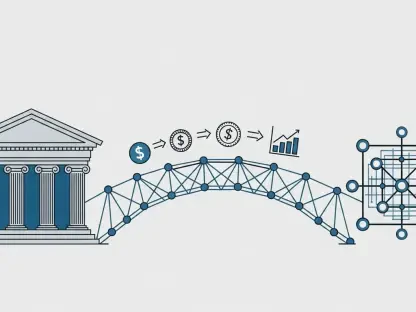In a landmark development that bridges the gap between traditional banking and cutting-edge blockchain technology, Fiserv, a prominent leader in payments and financial solutions, has joined forces with the state-owned Bank of North Dakota to unveil the Roughrider stablecoin, positioning North Dakota as only the second state in the United States, following Wyoming, to introduce a state-backed digital asset. Announced recently, this partnership underscores a transformative trend in the financial sector, where established institutions are increasingly exploring blockchain to enhance efficiency and accessibility in transactions. The Roughrider stablecoin not only integrates with Fiserv’s expansive digital asset ecosystem but also leverages the unique structure of North Dakota’s banking system to test groundbreaking approaches. As the world of finance continues to evolve, this initiative offers a glimpse into how state-backed digital currencies could redefine money movement, from interbank settlements to global payments, while navigating a complex regulatory landscape.
Driving Innovation in Financial Transactions
The primary objective behind the launch of the Roughrider stablecoin is to revolutionize the efficiency of financial transactions across various levels. Sunil Sachdev, Fiserv’s head of embedded finance and digital assets, has outlined that the initial focus will be on enabling 24/7 interbank money movement through a robust payment rail. This approach aims to significantly reduce the time and cost associated with bank-to-bank transfers, a critical pain point in traditional systems. By harnessing blockchain technology, the stablecoin promises near-instantaneous settlements, which could transform how financial institutions operate. Beyond the immediate benefits, this initiative sets a precedent for how digital currencies can streamline processes in an industry often burdened by outdated infrastructure, offering a potential blueprint for broader adoption in the financial ecosystem.
Expanding on this vision, the Roughrider stablecoin holds promise for applications beyond interbank transactions, with aspirations to impact global money movement and consumer interactions. Future use cases could include seamless cross-border payments, which often suffer from delays and high fees due to intermediary involvement. Additionally, there is potential for integration into consumer accounts, allowing individuals to engage directly with this digital currency for everyday transactions. Merchant adoption is another key area of focus, as businesses could benefit from faster payment processing and reduced transaction costs. This forward-thinking strategy aligns with the broader industry push to modernize financial systems, ensuring they keep pace with the demands of a digital economy. The collaboration between Fiserv and North Dakota exemplifies how state-backed initiatives can drive innovation while addressing real-world financial challenges with practical solutions.
A Unique Testing Environment in North Dakota
North Dakota’s distinctive financial landscape, anchored by the state-owned Bank of North Dakota with its $10 billion in assets, provides an unparalleled setting for piloting the Roughrider stablecoin. David Krause, an associate finance professor at Marquette University, has described the state as an “ideal live laboratory” for Fiserv’s technological advancements. The centralized structure of the Bank of North Dakota, which serves as a key partner to local financial institutions, minimizes operational complexities and compliance hurdles that might arise in larger, more fragmented markets. This controlled environment allows for meticulous testing of the stablecoin’s functionality, ensuring that any technical glitches or legal ambiguities are addressed before wider implementation. Such a setup offers a rare opportunity to refine blockchain-based solutions under relatively low-risk conditions.
Delving deeper into the advantages of this testing ground, North Dakota’s unique banking model facilitates close collaboration between state entities and private fintech firms like Fiserv. Unlike densely populated financial hubs where regulatory and operational challenges can be overwhelming, this state’s smaller scale enables faster decision-making and more agile experimentation. The Bank of North Dakota’s established role in supporting community banks further enhances the potential for real-world feedback on the stablecoin’s performance. If successful, the insights gained from this initiative could inform strategies for scaling similar projects to other regions. This partnership highlights how specific regional characteristics can be leveraged to pioneer financial technologies, potentially setting a standard for other states to emulate as they explore digital currency solutions.
Regulatory Challenges and Opportunities
The regulatory framework surrounding the Roughrider stablecoin presents both significant opportunities and notable challenges for its development and deployment. With the passage of the Genius Act by Congress, a federal structure for stablecoins has been established, yet state-issued digital currencies like Roughrider are exempt from direct federal oversight. Legal experts have pointed out that this exemption creates a form of “regulatory arbitrage,” allowing for greater flexibility in innovation compared to privately issued stablecoins, which face stringent requirements such as full reserve backing and regular attestations. While this lighter scrutiny fosters experimentation, it also raises concerns about potential systemic risks that could emerge without comprehensive federal guidelines. Balancing these dynamics is crucial for ensuring the stablecoin’s long-term viability.
Further exploring the regulatory landscape, the disparity between state and federal oversight introduces layers of complexity that stakeholders must navigate carefully. For state-backed initiatives, the reduced federal burden can accelerate development and deployment, positioning states like North Dakota at the forefront of financial innovation. However, this also means that state-level regulations must be robust enough to address any gaps left by federal exemptions. Legal analyses suggest that unresolved gray areas could pose challenges if systemic issues arise, potentially prompting indirect federal intervention through mechanisms like Financial Stability Oversight Council designations. The Roughrider stablecoin’s journey will likely serve as a critical case study in how state and federal policies can coexist, offering lessons on harmonizing innovation with the need for financial stability in an evolving digital economy.
Scaling for Interoperability and Future Growth
A key long-term goal for Fiserv in launching the Roughrider stablecoin is to ensure interoperability among various digital assets within its platform, including its own FIUSD stablecoin. Sunil Sachdev has emphasized the importance of creating a seamless ecosystem where connected stablecoins can interact effortlessly, enhancing the overall utility of digital currencies in financial systems. Meanwhile, David Krause suggests that demonstrating the effectiveness of this model in North Dakota could open doors to widespread adoption across thousands of institutions linked to Fiserv’s infrastructure. Such scalability is viewed as a strategic move to future-proof the company’s operations, aligning with emerging technologies that are set to redefine money movement. This focus on growth underscores the potential for state-backed stablecoins to transform broader financial networks.
Building on the theme of scalability, the success of the Roughrider stablecoin could catalyze a ripple effect throughout the industry, encouraging other financial entities to adopt similar blockchain solutions. Proving enhanced liquidity and transaction speed for North Dakota’s community banking partners would provide a compelling case for replication on a national or even global scale. Fiserv’s extensive network positions it uniquely to drive this expansion, leveraging lessons learned from this initial rollout to refine processes and address challenges. The emphasis on interoperability also ensures that as more stablecoins enter the market, they can function cohesively rather than in isolation, fostering a more integrated digital financial landscape. This vision of growth highlights the transformative potential of state-backed digital assets when supported by robust technological frameworks.
Growing State-Level Interest in Digital Assets
Beyond North Dakota’s pioneering efforts, a noticeable wave of interest in digital currencies is sweeping across other states, signaling a broader acceptance of blockchain technology in regulated environments. Wyoming has already set a precedent with its Frontier Stable Token, becoming the first state to launch a state-backed digital asset. Meanwhile, Nebraska has taken legislative strides with the Financial Innovation Act, establishing a charter for digital asset depository institutions. Telcoin Bank, poised to become the first such institution in the U.S., plans to issue its own stablecoin, eUSD, blending traditional banking safeguards with blockchain efficiencies. These developments reflect a shared ambition among states to modernize financial systems while maintaining consumer protections, positioning them as key players in the digital currency space.
Examining this trend more closely, the momentum at the state level illustrates a strategic effort to attract fintech and blockchain enterprises through clear regulatory pathways and controlled testing environments. States engaging in these initiatives gain a competitive edge by offering innovation-friendly climates, which could draw investment and talent to their regions. The collaboration between private companies and state entities, as seen in North Dakota and elsewhere, further accelerates the development of digital assets by combining technological expertise with institutional stability. Patrick Gerhart, president of banking operations at Telcoin, has highlighted the potential for these efforts to create safer, faster, and more transparent money movement systems. As more states explore similar projects, the collective impact could reshape the national financial landscape, paving the way for broader integration of digital currencies.
Reflecting on a Path Forward for Digital Finance
Looking back, the introduction of the Roughrider stablecoin through the partnership between Fiserv and the Bank of North Dakota marked a pivotal moment in the fusion of blockchain technology with traditional banking. This collaboration showcased how state-backed initiatives could drive financial innovation by leveraging unique regional advantages to test new systems. The focus on enhancing transaction efficiency and navigating regulatory nuances provided valuable insights into the potential and pitfalls of digital currencies. As challenges like interoperability and legal clarity were addressed, the groundwork was laid for future advancements in the sector. Moving forward, stakeholders should prioritize establishing cohesive state and federal frameworks to mitigate risks while fostering growth. Collaborative efforts across states, inspired by early movers like North Dakota and Wyoming, could help standardize best practices, ensuring that digital assets integrate seamlessly into the global economy with stability and trust at the forefront.









